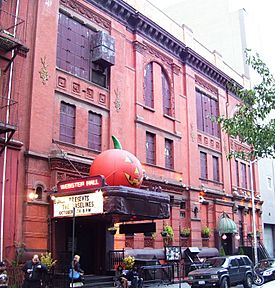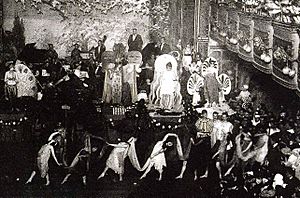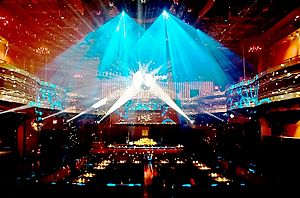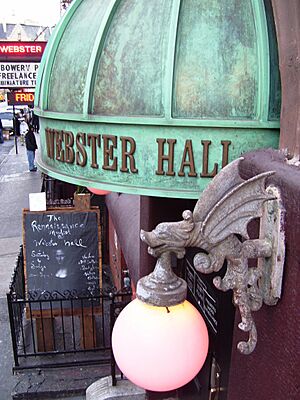Webster Hall facts for kids

Webster Hall just before Halloween 2010
|
|
| Former names | The Ritz |
|---|---|
| Address | 119-125 East 11th Street |
| Location | New York City |
| Public transit | New York City Subway: |
| Owner | Unity Gallega (Casa Galicia of New York) leased by AEG Presents, Brooklyn Sports Entertainment and The Bowery Presents |
| Type | Concert venue, nightclub |
| Capacity | Grand Ballroom: 1,500 Marlin Room: 600 Studio: 400 |
| Construction | |
| Built | 1886 |
| Renovated | 2018 |
| Webster Hall and Annex | |
|---|---|
| Lua error in Module:Location_map at line 420: attempt to index field 'wikibase' (a nil value). | |
| Architect | Charles Rentz |
| Governing body | private |
| Designated | March 18, 2008 |
Webster Hall is a famous nightclub and concert hall in New York City. You can find it in the East Village area of Manhattan. Since it was built in 1886, it has been a very important place for all kinds of social events.
Webster Hall is known as one of the first modern nightclubs. Because of its long history, it was named a New York City landmark in 2008. This means it's a special building that needs to be protected. After a big renovation, Webster Hall reopened in 2019, ready for more concerts and events!
Contents
The Early Years: 1886-1940
Webster Hall was built in 1886 by an architect named Charles Rentz. It had a special style called Queen Anne, with a fancy roof. A few years later, in 1892, another part was added to the building.
Over the years, the building had some fires, but it was always rebuilt. The original fancy roof was probably lost in one of these fires.
From the start, Webster Hall was a place you could rent for events. In its first years, it hosted many different gatherings. These included meetings for worker groups, weddings, lectures, and dances. It was a popular spot for working-class people and immigrants in the nearby Lower East Side.
Webster Hall also became known for its fun masquerade balls and parties in the 1910s and 1920s. Many famous artists and writers, like Marcel Duchamp and F. Scott Fitzgerald, went to events there. The end of Prohibition (when alcohol became legal again) was celebrated with a huge party called "The Return of John Barleycorn."
A Place for Music: 1950-1979
In the 1950s, Webster Hall started to feature many different kinds of music. Latin music stars like Tito Puente played there. Folk singers such as Pete Seeger and Woody Guthrie also performed.
From 1953 to 1968, a record company called RCA Records bought the building. They used Webster Hall as a recording studio on the East Coast. Many famous artists recorded their music here, including:
- Carol Channing (who recorded "Hello, Dolly!")
- Julie Andrews
- Harry Belafonte
- Tony Bennett
- Ray Charles
- Liza Minnelli
- Elvis Presley
- Frank Sinatra
Even Bob Dylan made his first recording here in 1962, playing harmonica on a song for Harry Belafonte.
In 1970, a cultural group called Unity Gallega (Casa Galicia of New York) bought the building. They still own it today and use it to promote the culture of Galicia, Spain.
Rock and Rebirth: 1980-2016
On May 1, 1980, a new rock club called The Ritz opened inside Webster Hall. It was a place for new rock bands to perform. Many big names played here often, such as:
The Ritz was thought to be one of the first clubs to use videos during performances.
When The Ritz moved in 1989, Webster Hall got a chance to be reborn. In 1992, the Ballinger brothers from Toronto reopened the hall. They made it modern with great sound, video, and lighting. They also brought back its original colors. On weekend nights, the venue would play two or three different types of music at the same time.
Webster Hall has hosted many special events. Madonna, Mick Jagger, and even Bill Clinton have had events there. It has also hosted wrestling shows and the taping of the "New York Special" for the TV show Iron Chef. The venue has five different rooms for events.
In the 2000s, people wanted to protect the historic buildings in the East Village. So, in 2007, a group worked to get Webster Hall recognized as a landmark. In 2008, it officially became a New York City landmark. This helps keep its unique history safe.
Webster Hall is also one of the city's top live music venues. It has hosted concerts for AOL and many famous bands. In 2007, Linkin Park filmed a concert there. Other popular artists who have played at Webster Hall include:
- Sonic Youth
- John Mayer
- Modest Mouse
- Charli XCX
- Wiz Khalifa
- Metallica
- Green Day
- LCD Soundsystem
In 2016, Webster Hall was even nominated for a "Nightclub of the Year Award" and won it the next year!
Recent Times: 2017-2019
In 2017, it was announced that Webster Hall had been sold to a company called AEG. The plan was for the venue to close for about two years for a big update.
The club officially closed on August 9, 2017. It underwent a $10 million renovation to make it even better for modern concerts and events.
After all the work, Webster Hall proudly reopened on April 26, 2019. The first concert was by the famous artist Jay Z!




